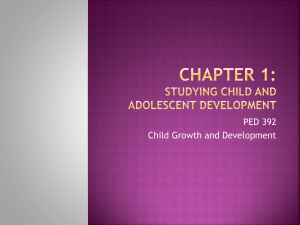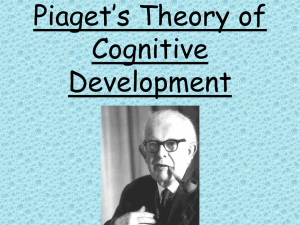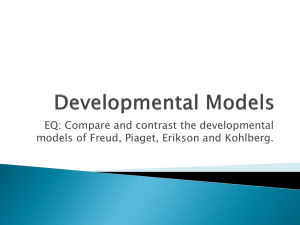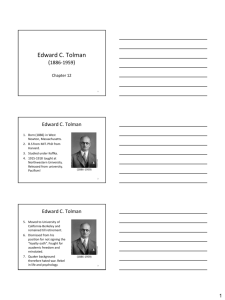Learning Theories
advertisement
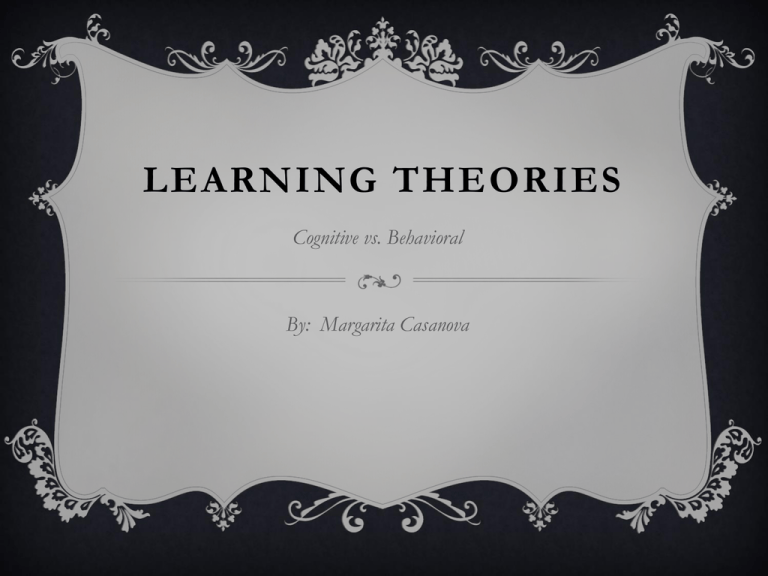
LEARNING THEORIES Cognitive vs. Behavioral By: Margarita Casanova JEAN WILLIAM FRITZ PIAGET JEAN WILLIAM FRITZ PIAGET COGNITIVE THEORIST (1896-1980) In 1918, Piaget received a doctorate from the University of Neuchatel Piaget did post-doctoral training in Zurich (1918–1919), and in Paris (1919–1921) In 1922, he moved to Geneva and he became the theorist we recognize today Piaget worked for Edouard Claparede as director of research at the Rousseau Institute P I A G E T ’ S C O N T R I BU T I O N S 1920’s - Piaget investigated the hidden side of children’s minds and proposed that children moved from a position of egocentrism to sociocentrism. 1934’s - He was the Director of the International Bureau of Education, he declared "only education is capable of saving our societies from possible collapse, whether violent, or gradual.” 1955’s - Piaget created the International Center for Genetic Epistemology in Geneva. 1960’s - American psychology incorporated the "Third Piaget“ logical model of intellectual development ideas. 2001’s – He process the reflecting abstraction through repeated actions, perhaps with variations or in different contexts or on different kinds of objects, the child is able to differentiate and integrate its elements and effects. PIAGET’S OF THE COGNITIVE DOMAIN Psychometric tests recognized by Piaget found it had limitations, as children were not able to provide the researcher with their deepest thoughts and inner intellect. Piaget’s observations theories of infant development were based on his own three children. Piaget was able to find significant differences in the way adults and children reason; • He was still unable to find the path of logic reasoning and the unspoken thoughts of children • It did not allow him to study a child’s intellectual development over time. EDWARD CHACE TOLMAN EDWARD CHACE TOLMAN B E H AV I O R A L T H E O R I S T ( 1 8 8 6 – 1 9 5 9 ) Tolman was an American psychologist who was famous for his studies on behavioral psychology. Tolman was born in West Newton, Massachusetts and had a brother of CalTech physicist Richard Chace Tolman. In 1915, Edward C. Tolman studied at the Massachusetts Institute of Technology where he received his Ph.D. from Harvard University. Tolman always mentioned that he was strongly influenced by the Gestalt psychologists, Kurt Lewin and Kurt Koffka. TO L M A N ’ S C O N T R I BU T I O N S Tolman paper with Ritchie and Kalish in 1946 was probably the most influential as best known for his studies of learning in rats by using mazes, plus published many experimental articles. In 1932, his book indicated that he wanted to use behavioral methods to gain an understanding of the mental processes of humans and other kinds of animals. Tolman “Drives Toward War” publication book had much concerned on psychology that he applied his technical theories to try to solve human problems. TO L M A N ’ S P E R F O R M A N C E T H E O RY Tolman demonstrate that animals could learn facts about the world. The animals could subsequently use in a flexible manner, rather than simply learning automatic responses which can be triggered off by environmental situations. He mentions of three different variables that influence behavior are: • independent • intervening • dependent variables The experimenter can manipulate the independent variables; • These independent variables in turn influence the intervening variables • Independent variables are also factors of the subject that the experimenter specifically chooses for. TO L M A N ’ S TY P E S O F P RO P O S E D L E A R N I N G In 1932 Tolman proposed five types of learning: • • • • • approach learning, escape learning, avoidance learning, choice-point learning latent learning Tolman proposed that all forms of learning depend upon means-end readiness, goal-oriented behavior, mediated by expectations, perceptions, representations, and other internal or environmental variables. S UMMARY : APPLICATION OF LEARNING THEORIES ON ADULT EDUCATION Piaget- Piaget was able to find significant differences in the way adults and children reason by a child progresses thinking; they learn thinking skills such as words, symbols and images to represent the world. These stages called sensorimotor and preoperational adults must grasp these concepts in childhood because if they do not an adult may struggle to fit in or function as adult. Tolman- A child perceives "yes” if he or she feels loved, secure, and confident, and, behaviorally. The child is more likely to explore his or her environment and play with others sociably. A child perceives "no" the child experiences anxiety and behaviorally. The child is less likely to exhibit attachment behaviors ranging from simple visual searching on the low extreme to active following and vocal signaling. WORKS CITED n.d.). Retrieved from http://www.instructionaldesign.org/theories/sign-theory.html (n.d.). Retrieved from http://en.wikipedia.org/wiki/Edward_C._Tolman n.d.). Retrieved from http://en.wikipedia.org/wiki/Theory_of_cognitive_development (n.d.). Retrieved from http://users.accesscomm.ca/vendra/EDU 533/Behaviorism , Cognitive Psychology and Constructivism.htm


